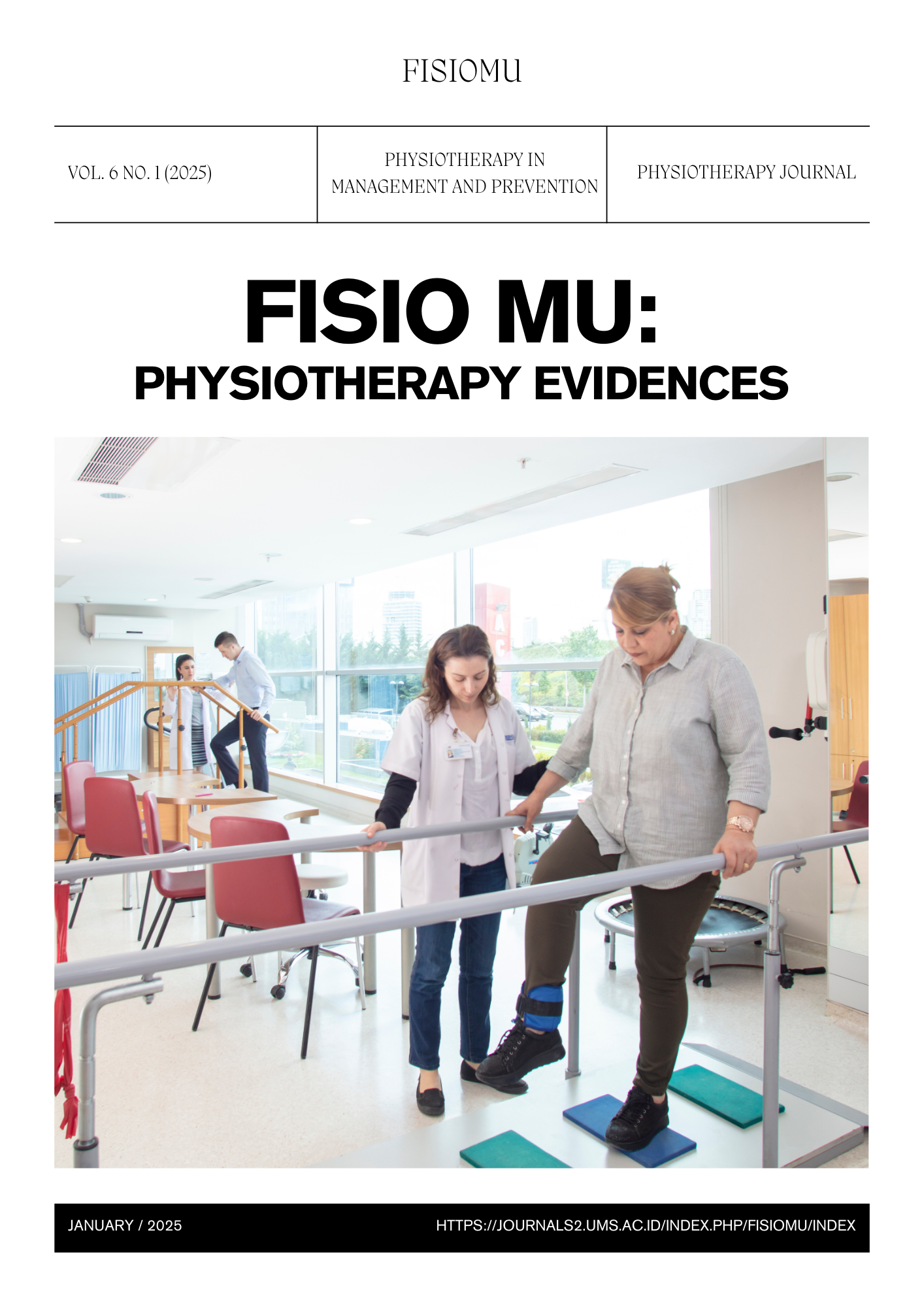Relationship Between Work Position and Non-Specific Low Back Pain Incidence in Farmer Groups
DOI:
https://doi.org/10.23917/fisiomu.v6i1.3002Keywords:
Farmers, Non-specific Low Back Pain, Working postureAbstract
Introduction: Farmers are someone who spends a lot of time in the field to plant, fertilize and harvest. During the process of planting, farmers tend to be in a bent position for a long time. Low back pain is one of the complaints that can reduce human productivity. Low back pain does not recognize gender, age, or social status. Non-specific low back pain results in pain, muscle spasms, and muscle imbalance, so the stability of the abdominal and lower back muscles decreases, limited lumbar mobility, changes in posture and results in disability in sufferers of non-specific low back pain. The students aim to determine whether there is a correlation between working posture and the incidence of non-specific low back pain in farmers. Methods: The research method used by sampling using total sampling, the dependent variable was the work position and the independent variable in the researcher's research was non-specific low back pain. Results: Sig value. (2-sided) in the chi-square test is 0.018. Because the sig value (2-sided) is 0.018<0.05, then based on the decision-making above, it can be concluded that Ho is rejected Ha is accepted. This means that there is a relationship between working posture and non-specific low back pain in farmer groups. Conclusion: There is a correlation between working posture and the incidence of non-specific low back pain in farmers. Future researchers are expected to add or examine further related postures while working on workers and increase the number of respondents to be more relevant in the coming years
Downloads
References
Andini, F. (2015). Risk Factors of Low Back Pain in Workers. Medical Journal of Lampung University, 4(1), 12–17.
Atmantika, N. B. (2014). Hubungan antara intensitas nyeri dengan keterbatasan fungsional aktivitas sehari-hari pada penderita. Universitas Muhammadiyah Surakarta, 1(1), 1–17.
Christia E. Malonda, Paul A.T Kawatu, D. V. D. (2016). Gambaran Posisi Kerja Dan Keluhan Gangguan Musculoskeletal Pada Petani Padi Di Desa Kiawa 1 Barat Kecamatan Kawangkoan Utara. Pharmacon, 5(4), 267–272.
Djawas, F. A. (2022). Jurnal Fisioterapi Terapan Indonesia or Indonesian Journal of Applied Physiotherapy Efektivitas Terapi Latihan terhadap Kemampuan Fungsional Post Rekonstruksi ACL Grade 2 Efektivitas Terapi Latihan terhadap Kemampuan Fungsional Post Rekonstruksi ACL Grade. 1(1). DOI: https://doi.org/10.7454/jfti.v1i1.1027
Eliyana, L. (2017). Anatomi Terapan dan Biomekanik. Journal of Muhammadiyah Malang University, 44(8), 9–36. https://doi.org/10.1088/1751-8113/44/8/085201 DOI: https://doi.org/10.1088/1751-8113/44/8/085201
Fatimah. (2012). Penentuan Tingkat Resiko Kerja Dengan Menggunakan Score Reba. Industrial Engineering Journal Vo.1 No, 1(1), 25–29.
Hadyan, M. F., & Saftarina, F. (2017). Hubungan Usia, Lama Kerja, Masa Kerja dan Indeks Massa Tubuh (IMT) Terhadap Kejadian Low Back Pain (LBP) pada Petani di Desa Munca Kabupaten Pesawaran. Medula, 7(4), 141–146.
Kaur, K. (2016). Prevalensi Keluhan Low Back Pain (Lbp) Pada Petani Di Wilayah Kerja Upt Kesmas Payangan Gianyar April 2015. Intisari Sains Medis, 5(1), 49–59. https://doi.org/10.15562/ism.v5i1.35 DOI: https://doi.org/10.15562/ism.v5i1.35
Kurniawan, G. P. D. (2019). Mckenzie Excercise dalam Penurunan Disabilitas Pasien Non-Specific Low Back Pain. Quality : Jurnal Kesehatan, 13(1), 5–8. https://doi.org/10.36082/qjk.v13i1.53 DOI: https://doi.org/10.36082/qjk.v13i1.53
NUGRAHA, D. (2019). PREVALENSI NYERI PUNGGUNG BAWAH (LOW BACK PAIN) PADA PEMBATIK DI KECAMATAN LENDAH, KABUPATEN KULON PROGO. 1–2.
Nugroho, A., Caesarina, A., Marchianti, N., & Hermansyah, Y. (2017). Influence of Workload Level on Low Back Pain Patient’s Physical Disabilities at RSD dr. Soebandi Jember. Jurnal Kesehatan, 5(2), 1–7.
Oktavian Rumangu, Achmad Paturusi, M. R. (2021). Hubungan.Posisi.Kerja.Dengan.Keluhan. Musculoskeletal. 02(02).
Rahmawati, A. (2021). Risk Factor of Low Back Pain. Jurnal Medika Hutama, 3(1), 402–406.
Sutami, N. K. D., & Laksmi, I. A. A. (2021). Hubungan Durasi Kerja Dan Posisi Kerja Dengan Kejadian Nyeri Punggung Bawah Pada Petani. Journal of Borneo Holistic Health, 4(2), 85–96. https://doi.org/10.35334/borticalth.v4i2.2028 DOI: https://doi.org/10.35334/borticalth.v4i2.2028
Ulandari, S. (2017). ANALISIS POSTUR KERJA DENGAN KELUHAN LOW BACK PAIN PADA PEKERJA PENCETAK GENTENG DI KABUPATEN BLITAR (Studi pada Pekerja Pencetak Genteng di Dusun Bendorejo Desa Bendosewu Kecamatan Talun Kabupaten Blitar. Universitas Jember. https://repository.unej.ac.id/handle/123456789/83151
Yeni Vera, Maryaningsih, A. B. H. (2022). Prevalensi dan karakteristik low back pain pada petani di desa raso kecamatan kolang kabupaten tapanuli tengah 1,2. 24(1), 27–31.
Zahra, I., Yasya, K., & Simbolon, S. P. (2019). Gambaran Kemampuan Fungsional Low Back Pain Miogenik Buruh Tani padi di Desa Tanjungkulon. 2017–2020.
Downloads
Submitted
Accepted
Published
How to Cite
Issue
Section
License
Copyright (c) 2024 Fisio Mu : Physiotherapy Evidaces Journal

This work is licensed under a Creative Commons Attribution-NonCommercial-NoDerivatives 4.0 International License.

This work is licensed under a Creative Commons Attribution-NonCommercial 4.0 International License.
Authors who publish with FISIO MU: Phsiotherapy Evidences agree to the following terms:
- Author(s) retain copyright and grant the journal right of first publication with the work simultaneously licensed under a Creative Commons Attribution-NonCommercial 4.0 International License that allow others to share the work within an acknowledgement of the work’s authorship and initial publication of this journal.
- Author(s) are able to enter into separate, additional contractual arrangement for the non-exclusive distribution of the the journal’s published version of the work (e.g. acknowledgement of its initial publication in this journal).
- Author(s) are permitted and encouraged to post their work online (e.g. in institutional repositories or on their websites) prior to and during the submission process, as it can lead to productive exchanges, as well as earlier and greater citation of published works.












